MARKETING
2023’s Top 7 Local Search Ranking Factors, Illustrated and Explained

The author’s views are entirely their own (excluding the unlikely event of hypnosis) and may not always reflect the views of Moz.
Learning to be the best in town at the top seven elements experts feel impact your rankings in Google’s local packs is a smart strategic foundation. Thanks to Darren Shaw who has been running the Local Search Ranking Factors survey since 2017, we all benefit from this respected annual report in which local SEO professionals get to pool their practical knowledge of what they see impacting clients’ rankings most.
Today, we’re going to look at how to set the local businesses you market apart by mastering the tippy-top of the list of factors, with lots of practical tips for improving your rankings so that you’re earning greater visibility.
But, first, what is a local pack?
This is the umbrella term for the local business results Google displays when it feels a searcher’s query has a local intent. Local packs have a variety of formats, like this one with the large map and lettered results:
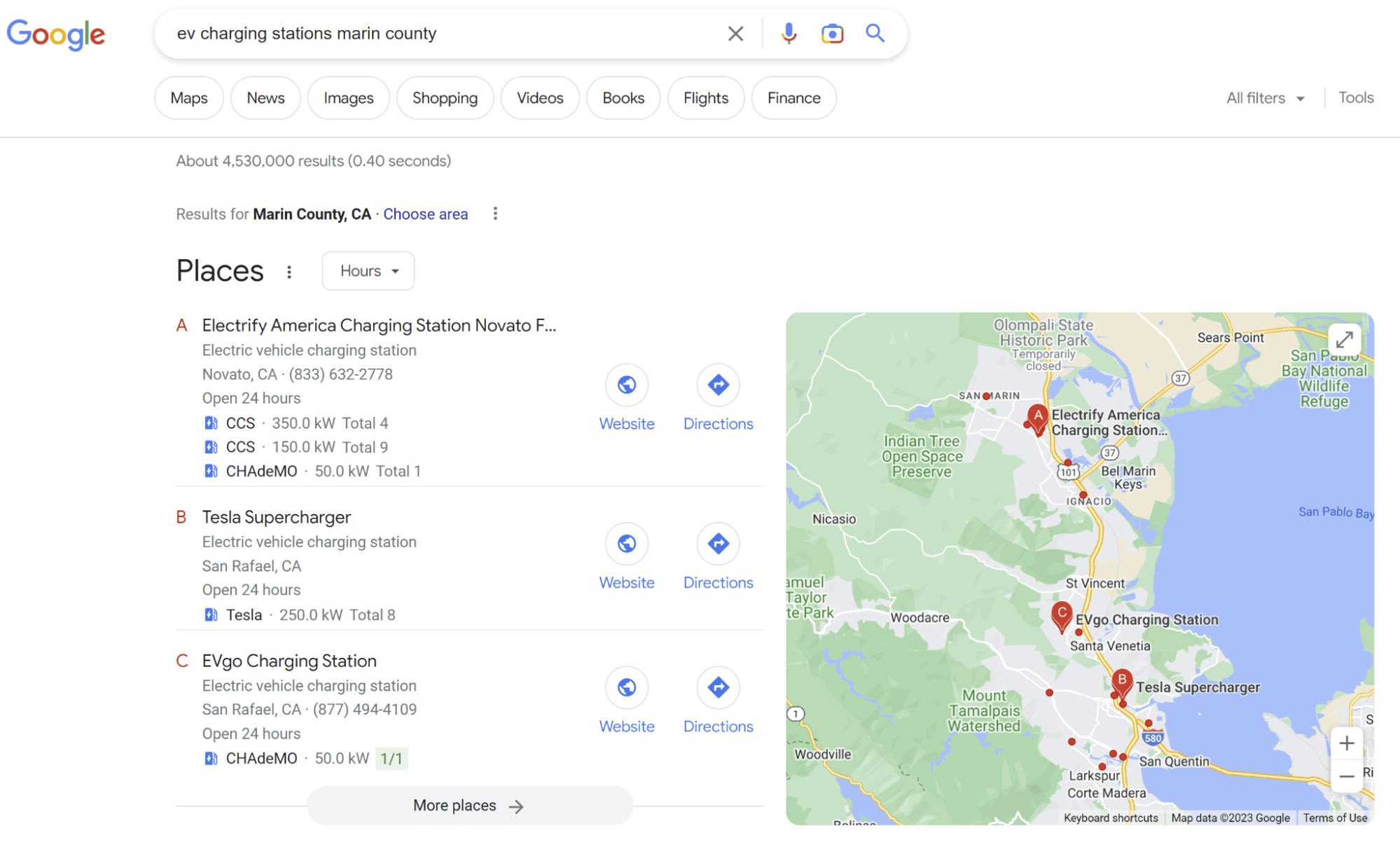
And this one, also with the large map, but no letters and no links to the website or driving directions:
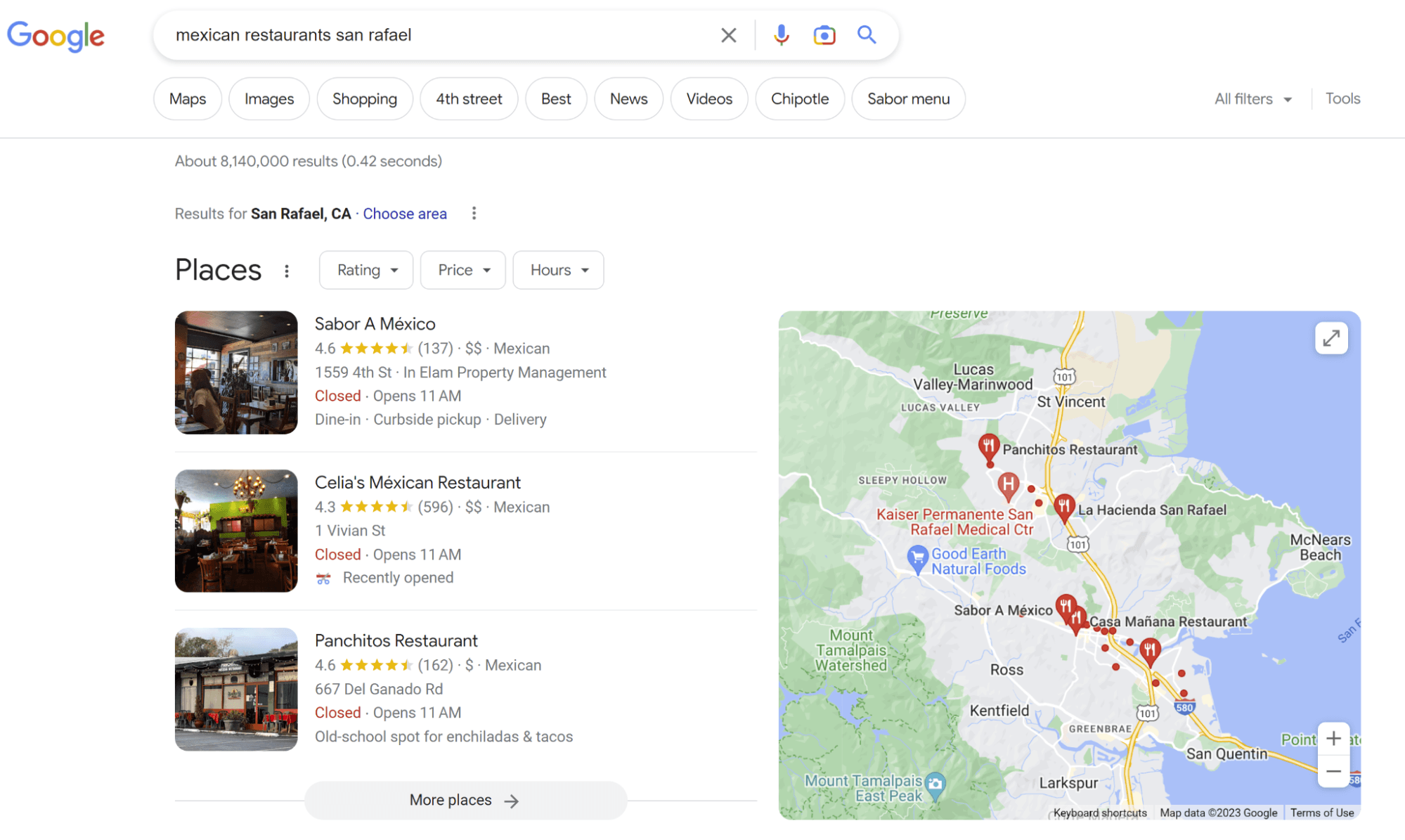
And this one, with the map above the results, and again, no letters or website/directions links:
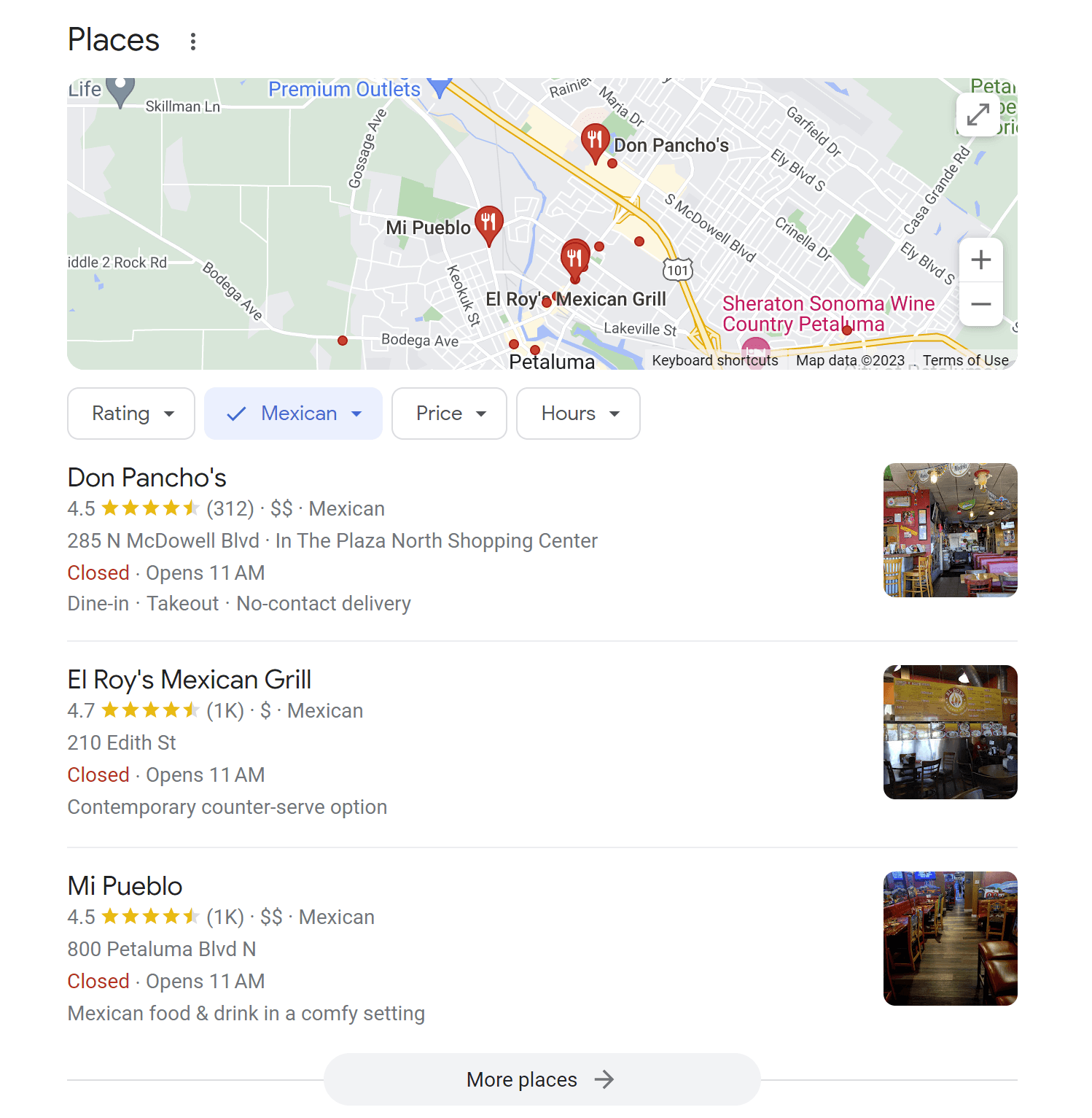
There are many variations, based on query, industry, and device. Frequently, local packs appear above the organic results, but they can also be displayed further down the page. Mostly, local packs contain three results, but this number can sometimes change and they may also contain paid ads. Aspects of your Google Business Profile, as well as other sources like your own website and third-party websites, have a demonstrable impact on whether or not you show up in Google’s local packs and the extended listings they click to that are called the Local Finder results.
Now that we’ve got that covered, let’s look at this year’s 7 most influential local pack ranking factors.
1. Primary Google Business Profile category
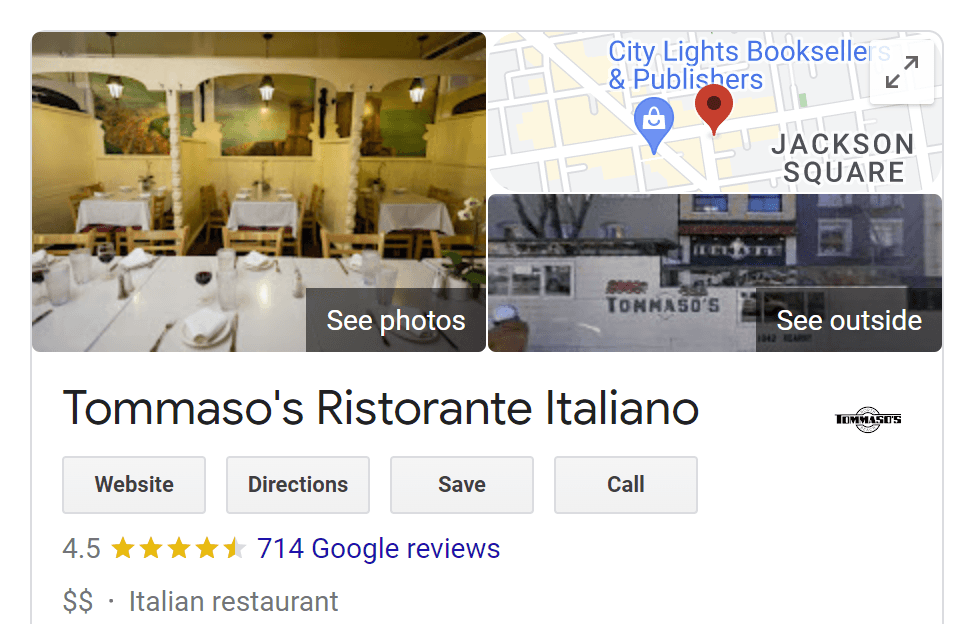
It’s a local search fact of life that you can’t rank for your most important search phrases unless you’ve selected the right GBP category, and the primary category matters most. Usually, Google displays the primary category on your Google Business Profile (see “Italian restaurant”, above), but not always. You select your primary category by logging into your Google account, searching for your business by name, and then clicking on the Edit Profile tab in the New Merchant Experience editor:
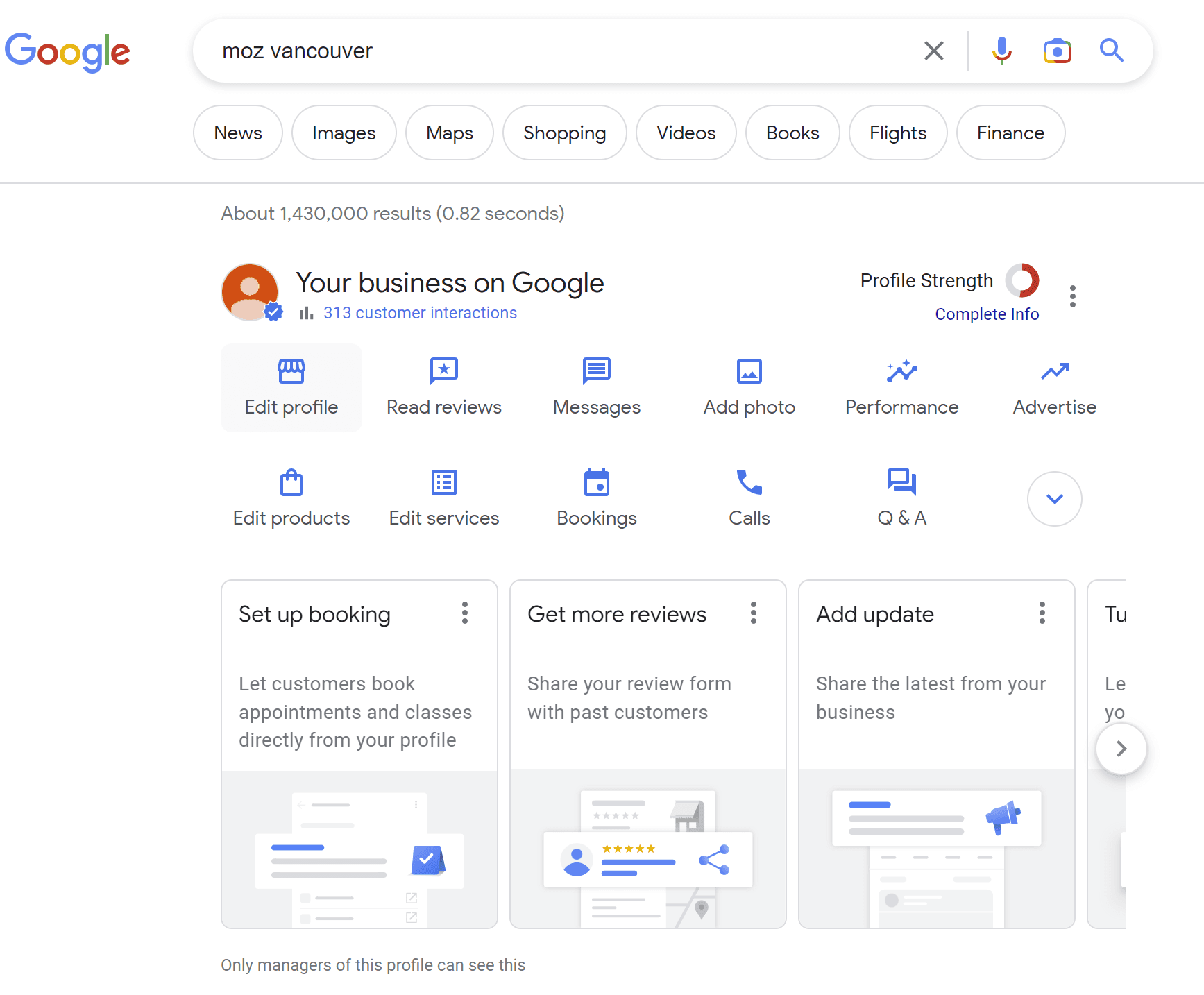
Your primary category is the one you enter into the primary category box, and you can add a total of ten categories:
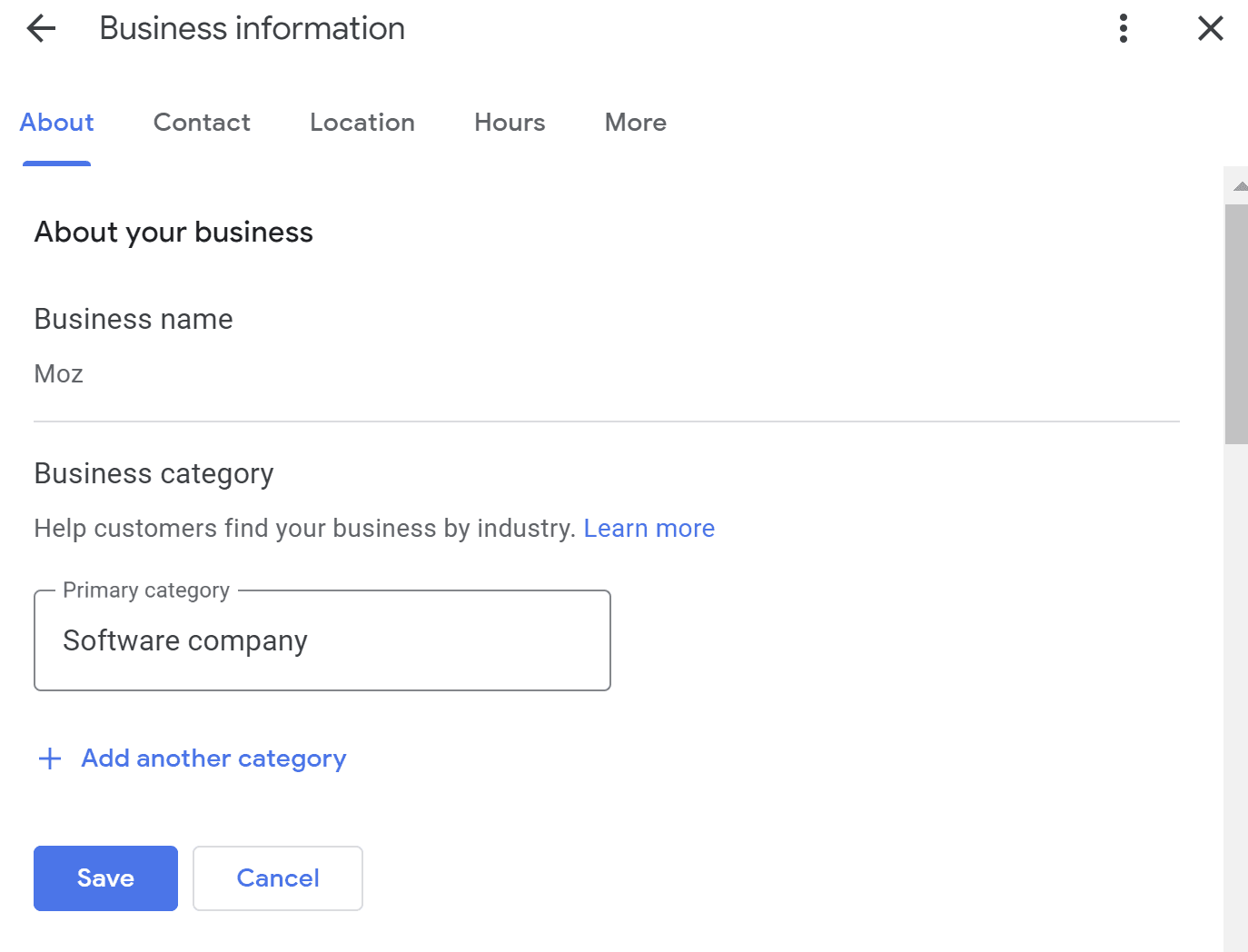
To discover the best category for your business, follow these steps:
-
Search for the #1 phrase for which you most need to rank in the local results and look at which categories the top-ranked businesses are using.
-
If you see diverse categories represented amongst the top 3 businesses, note which one most closely matches your business. For example, is your broadest and most accurate category “Italian restaurant” or “Fine dining restaurant”?
-
If the listing you are creating isn’t for your main business but is for a practitioner within a multi-practitioner company (like a legal firm with three lawyers or a dental practice with five dentists), try to diversify the categories you choose so that they don’t compete with the main listing for the practice.
-
If the listing you are creating is for a multi-location business, it’s okay to use the same primary category across all your listings, but if the close proximity of one branch to another appears to be causing one of your locations to be filtered out and invisible in the local packs, consider diversifying your primary categories.
-
If your market research indicates that your local market is extremely competitive/crowded for a particular category (think personal injury attorneys in Los Angeles), make a decision about whether you can reasonably compete for local pack visibility for the same category the top competitors are using, or whether you want to try to earn business from a less competitive category while you work to establish the brand you are marketing. Note how most of these businesses have chosen the primary category “Italian restaurant”, but one has chosen to be more specific with “Northern Italian Restaurant”:
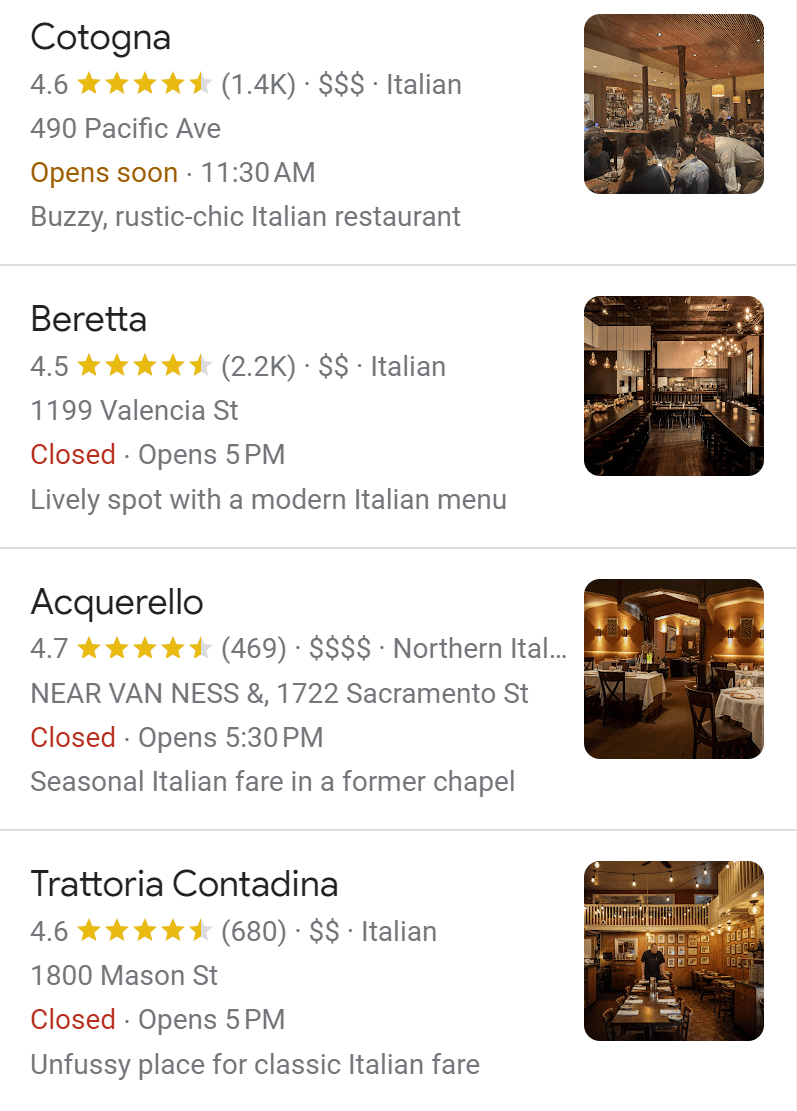
That small difference could either positively or negatively impact the restaurant’s ability to rank for its most desired search phrases. So, pick a primary category, but don’t be afraid of changing it at a later date if you feel it might be holding you back. Testing is a smart practice.
We’ll be returning to the topic of choosing categories when we get to factor #7, below.
2. Keywords in Google Business Profile business title
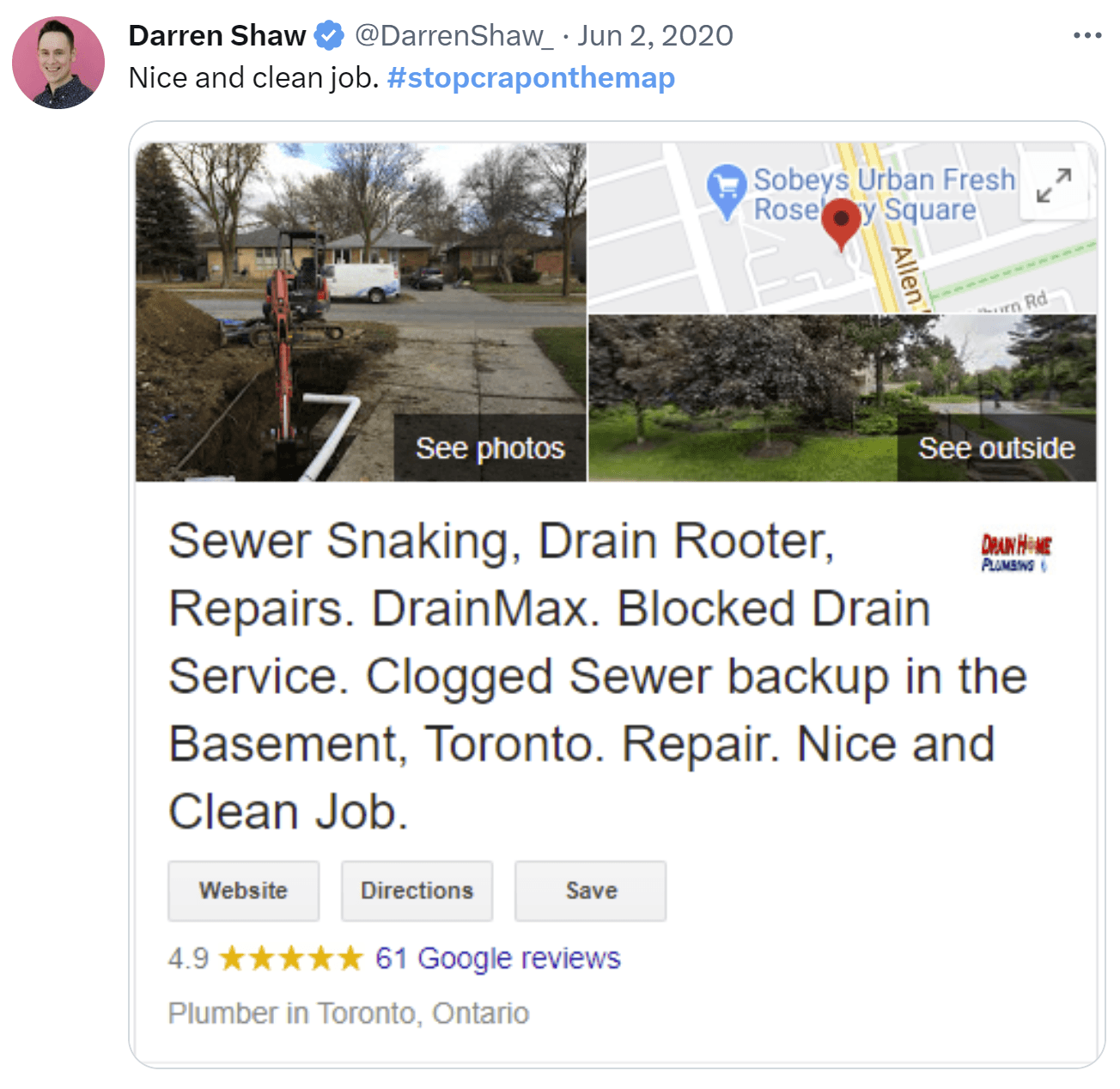
Local SEOs keep a running agony column of spammy GBP business title examples, like this tweet from Darren Shaw. Unfortunately, seeing that keywords in the business title is such a powerful ranking factor can mislead business owners and marketers into believing they should be putting something other than their real world business name in this field of the New Merchant Experience editor:
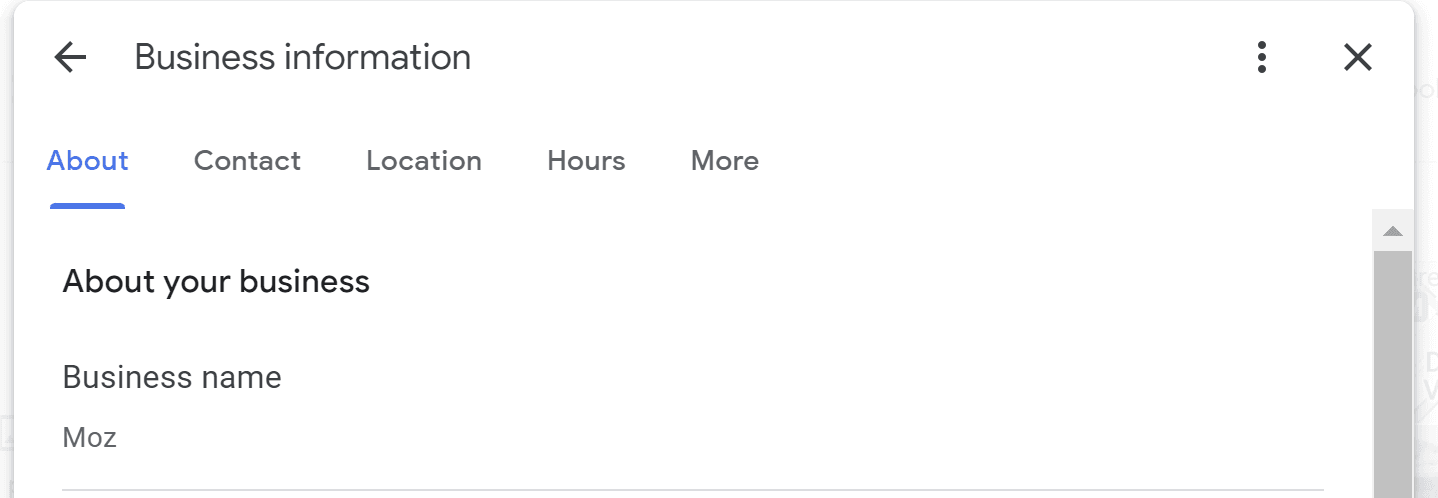
The field is meant to contain only your real-world business name as it appears on your street signage with no extraneous keywords. In this screenshot, you can see that the name is just listed as “Moz”. Not “Moz Vancouver” or “Moz Seattle” or “Moz best SEO software company in America”.
Unfortunately, a weak spot in the algorithm Google uses to order results causes them to reward listings with spammy business titles. It’s probably the least-sophisticated aspect of Google’s system that it can be fooled by keyword-stuffing business titles. You can flag businesses with spammy names, and sometimes Google will edit them, but the penalties are never severe and, in my experience, the spammy names often simply re-appear shortly thereafter.
This problem with the system has business owners and marketers wondering whether they should be honest or try to game the system. Of course, the former is the best policy for companies that plan to build a lasting good reputation, but here are a few tips to help you work amid a rather messy scenario:
-
If you are trying to understand how to write the business title for something other than a single location business (such as a co-located business, solo practitioner, or multi-practitioner business), consult the Guidelines for Representing Your Business on Google for detailed instructions.
-
Feel free to report competitors in your market with spammy business names. Google may or may not act on your reports, but if they do, it can help decrease the ranking power of spammers and help your listing with its legitimate name move up.
-
Don’t name your business something that could limit its future growth. For example, think carefully before calling your new restaurant “Tacos San Diego” if there is any possibility that you may someday open branches in San Jose, San Francisco, and Santa Rosa.
If circumstances have made you realize that your real-world business name appears to be holding you back, you do have the option to legally change your name. If you decide on this course of action, try to choose a name that will stand you in good stead for many years to come. Be wary of trendy fads. For example, some local businesses have gone viral, as in the case of a NYC restaurant named “Thai Food Near Me”, but be careful you aren’t dubbing yourself with a phrase that could look dated three years from now.
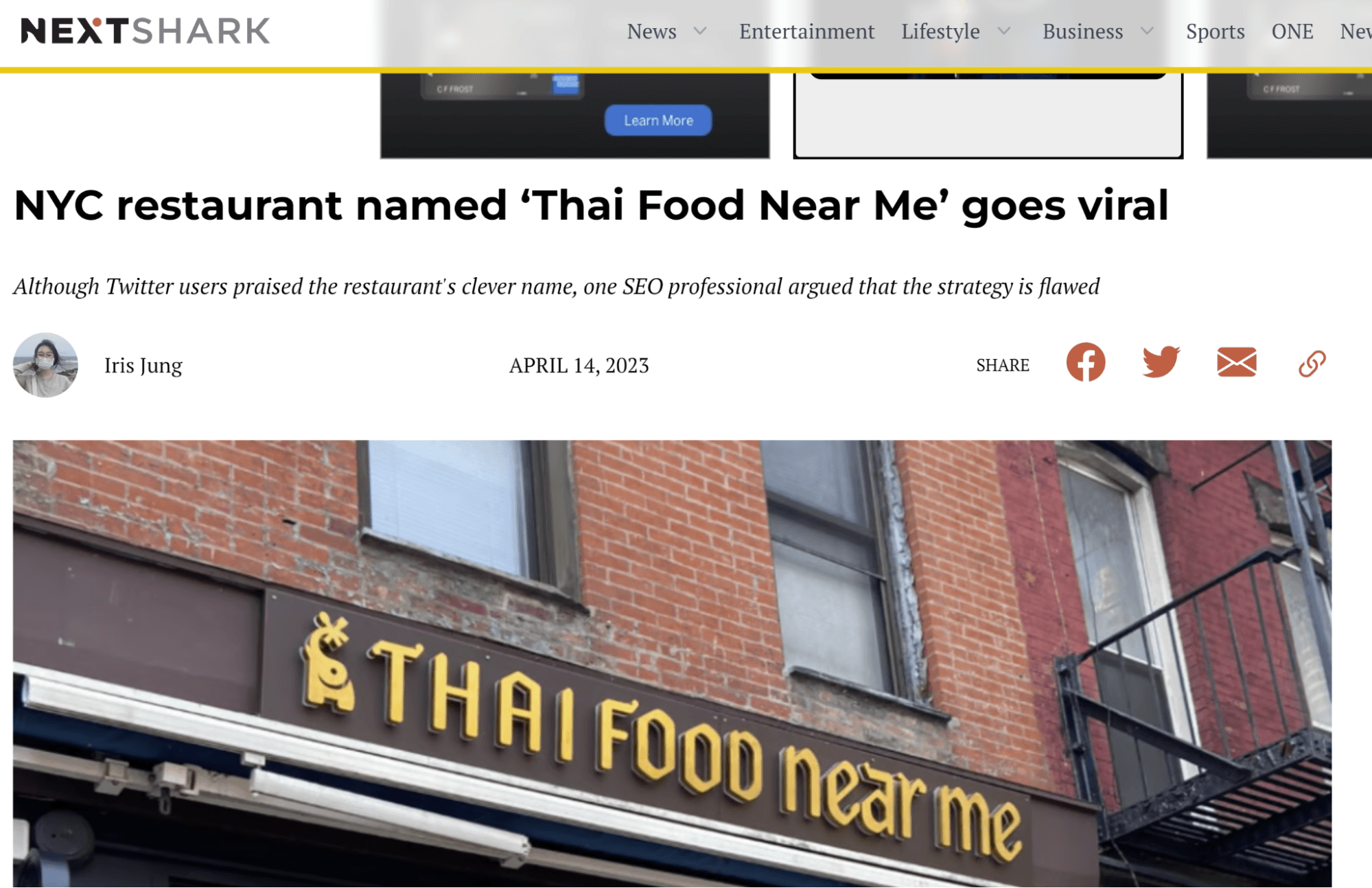
If your company does rebrand, be sure to update all legal registrations, local business listings across the local search ecosystem, all social media profiles, and all references to the old name on your website and third-party websites
3. Proximity of address to the point of search
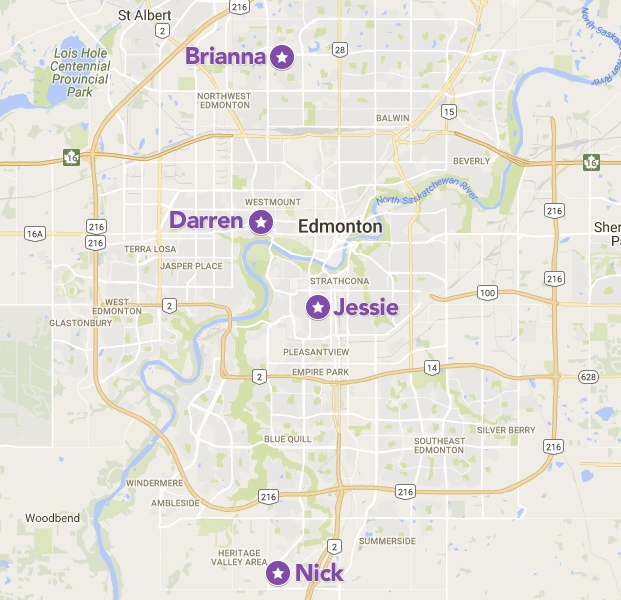
Back in 2017 when Darren Shaw first noted that the distance between the person searching and the thing being searched for had become the #1 local search ranking factor, he created the above graphic to illustrate this phenomenon. Your business may be situated on Jasper Avenue near the center of Edmonton, but each of your customers is in a different location, on a different device.
In 2023, proximity of address to the point of search may have slipped to number 3, but it is still every bit as important to understand that there are no static number 1 local search rankings because Google shows each of your customers different results based, in part, on the location of their mobile phone, laptop, or other device. You can witness this in action by walking or driving around town, searching for the same keyword phrase. Local market research involves either engaging in this process manually to assess your overall visibility throughout your market, or using a local rank checker like the ones offered by Whitespark, Local Falcon, or Mobile Moxie’s Serperator.
You can’t control where your customers are and the only option you have if you discover your physical address is limiting your ability to meet goals is to move to a new location (a daunting prospect). What every local business marketer can and should do, however, is to observe how Google is behaving for each desired search phrase.
For example, you might discover that when you search for “tacos”, Google is casting a very narrow net for local results, showing restaurants mainly clustered in a single neighborhood of your city. But when you change your search to “organic vegan tacos”, suddenly Google is widening the net to encompass the whole city or even reaching beyond city boundaries. That’s amazing business intelligence because it shows you opportunities to optimize for more specific terms and show up for more distantly-located customers. Use this knowledge in choosing your:
-
Categories
-
Services
-
Photo and video subjects
-
Attributes
-
Website topics
While you can’t control Google’s heavy emphasis on proximity, you can respond to it with a smart local search strategy. And this segues nicely into the next factor.
4. Physical address in city of search
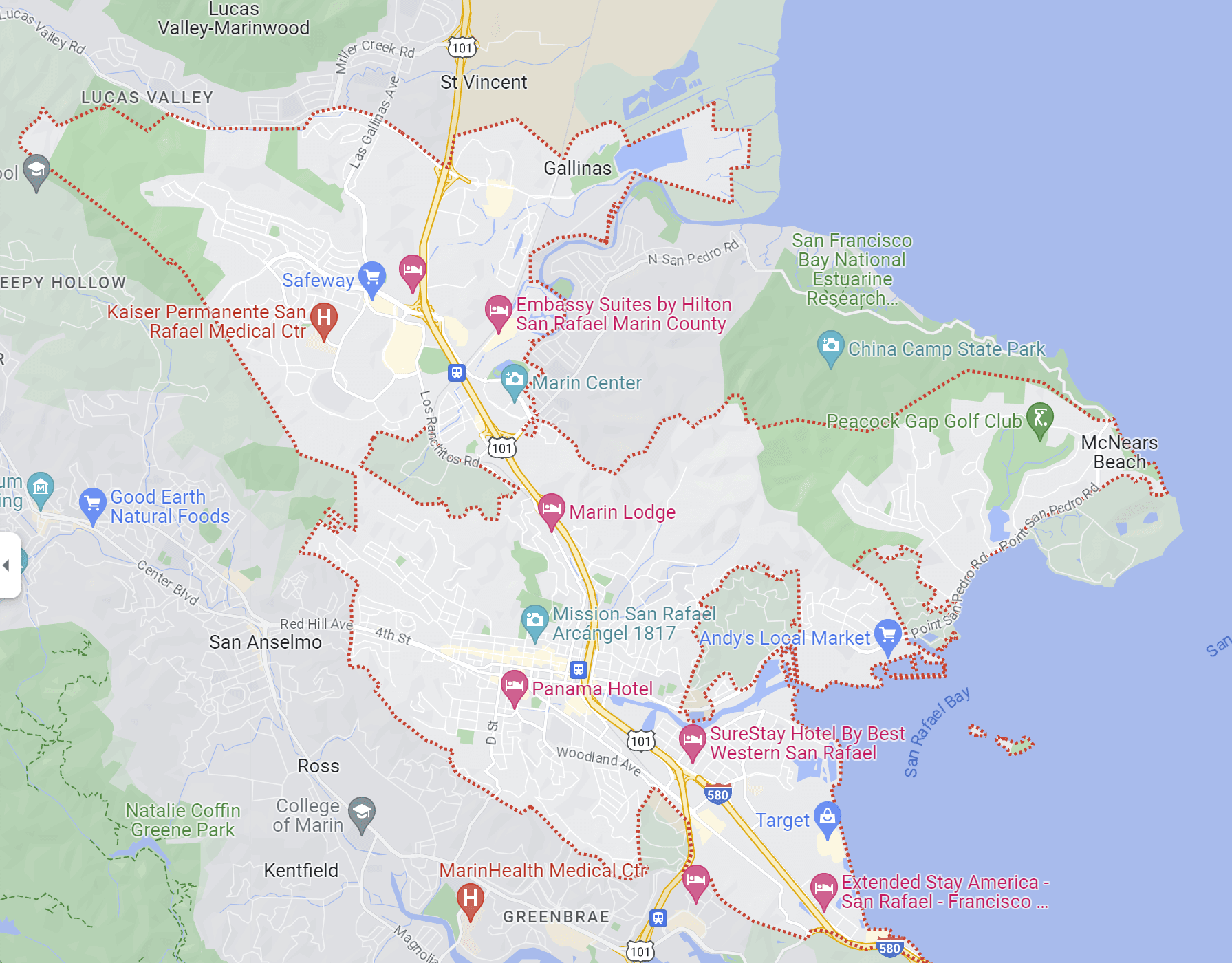
Look up your city in Google and click on the map. The red border, as shown above, indicates Google’s concept of the perimeters of your town or city. The reason this matters to local SEO is that businesses located beyond the border often have a much harder time becoming visible for searchers located within the border or for search phrases that contain the name of the town or city.
“I want to rank beyond my location,” has got to be one of the commonest requests local SEOs hear from clients (so common that I wrote an entire column about this in 2019 you might like to read). If you come to suspect that your physical address is severely limiting the number of customers who are finding you online, you have three main options:
-
Moving to a new location inside Google’s borders
-
Re-optimizing your presence to compete for less-competitive terms, as described in relation to factor #3
-
Making a substantial investment in multiple aspects of your local search marketing so that your Google Business Profile becomes so strong that it overcomes Google’s city border bias.
There is no guarantee that the third option will work, but it is often the best bet. To undertake this work from an informed stance, you will need to conduct a competitive local business audit of the top competitors for each of your most important search phrases. By using the free spreadsheet included in that article, you will be able to identify multiple factors that are likely contributing to the high visibility of the top-ranked competitors, and determine what you need to do to surpass their efforts. You may find yourself investing in review acquisition and management, local business listing development, link building, content development, and other areas. Sometimes, you can find sweet spots in which Google is willing to go beyond the borders for strong brands, so studying the maps and Google’s behavior is an essential local search marketing habit.
5. Removal of spam listing through spam fighting
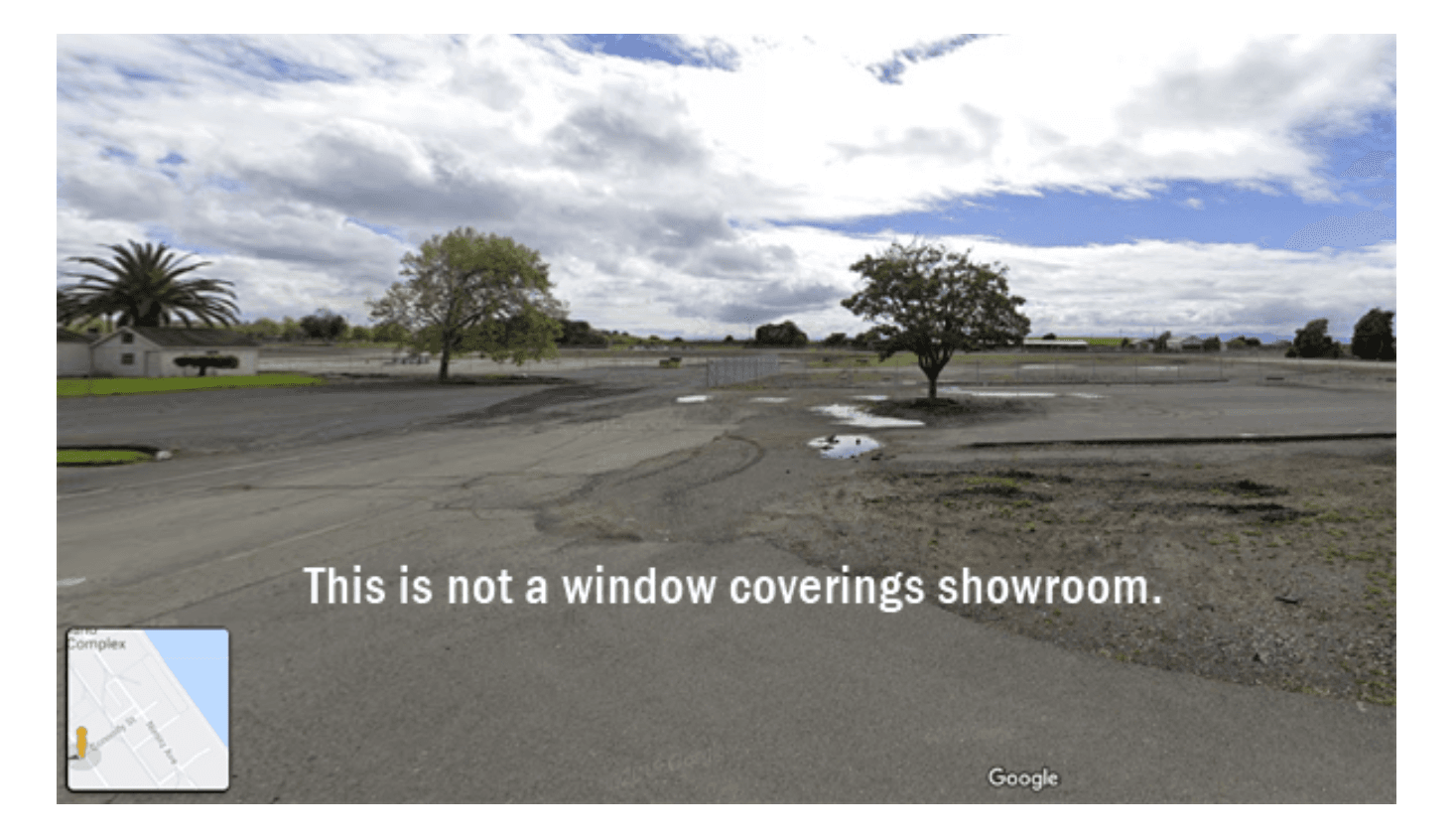
Four years ago, I wrote a column on Simple Spam Fighting: The Easiest Local Rankings You’ll Ever Earn and I’m sorry to say that the tactics I covered for recognizing spam are every bit as necessary today as they were back then. Google’s listing spam problem is massive. Both novice and bad actors have filled up the index with results that mislead the public and violate Google’s guidelines.
It’s a sad story that’s as old as local search, and every year is a new year to hope that Google will give more attention to protecting businesses from misrepresentation and unfair competition, while protecting consumers from disinformation. Perhaps the challenges now being posed by AI, like ChatGPT, and competitors for attention, like TikTok, will put some healthy pressure on Alphabet to defend the relevance of Google’s local results.
In the meantime, local business owners and their marketers have the toilsome (yet, perhaps satisfying?) option of reporting spam listings so that they can move up in the local pack rankings if/when the spammers are removed. To do this effectively, you need to know what constitutes spam in Google’s environment. This can range from:
Learn the Guidelines for Representing Your Business on Google like the back of your hand, and you will become adept at spotting listing spam. When you believe you’ve encountered a spam listing, your best bet is to use the business redressal form to report it. If you come across a widespread pattern of spam in a given results set and use of the form isn’t getting any traction, you may need to use your marketing skills to bring public attention to the problem in hopes of inspiring Google to act. Want more spam fighting tips? Sterling Sky has a good piece on this.
6. High numerical Google ratings
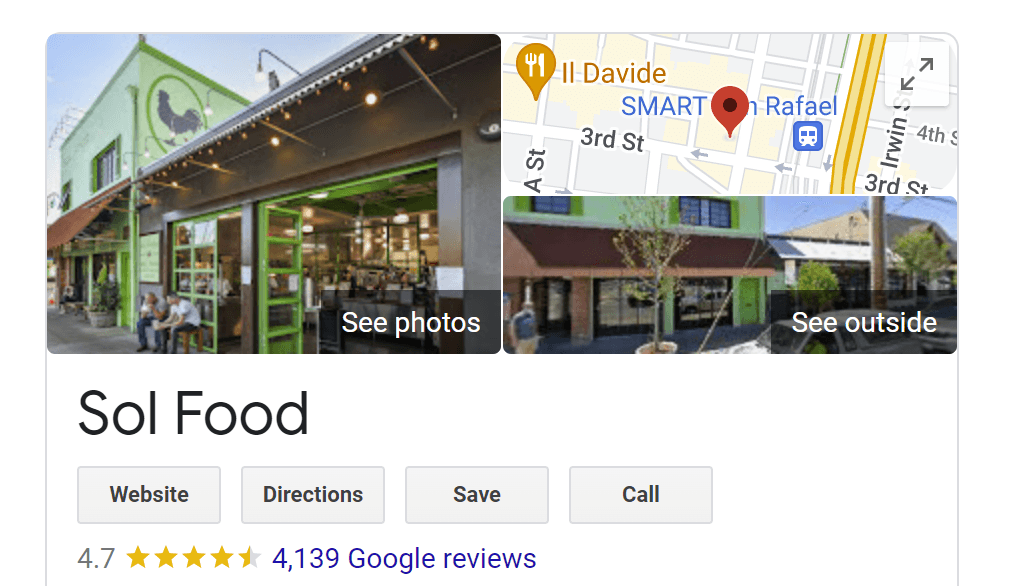
Your average star rating isn’t just a top local pack ranking factor, but it’s also a top conversion factor. In our report on the Impact of Local Business Reviews on Consumer Behavior, respondents cited the star rating as the most important component of reviews:
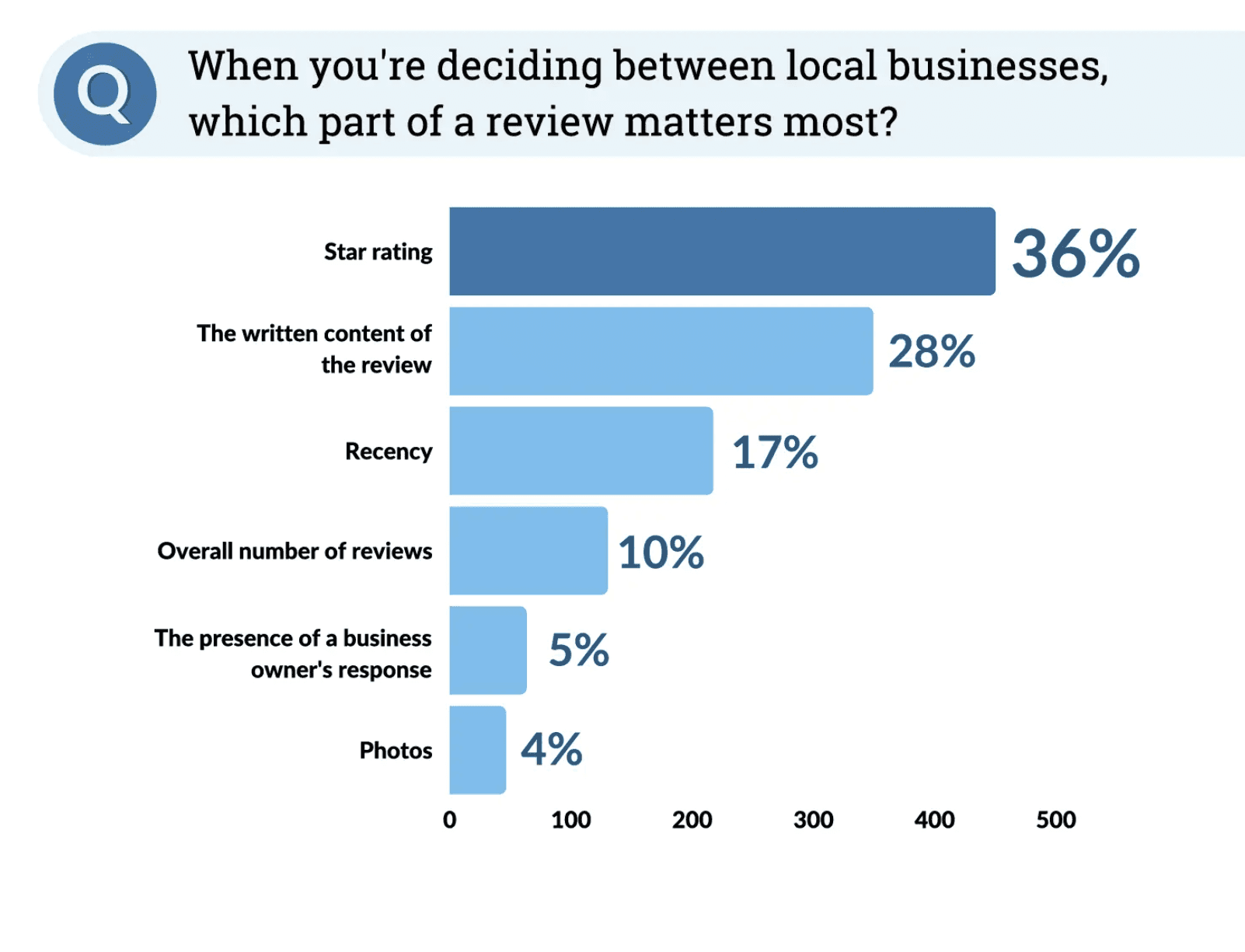
Meanwhile, a majority of 51% say a business must have at least 4 stars for them to consider choosing it.
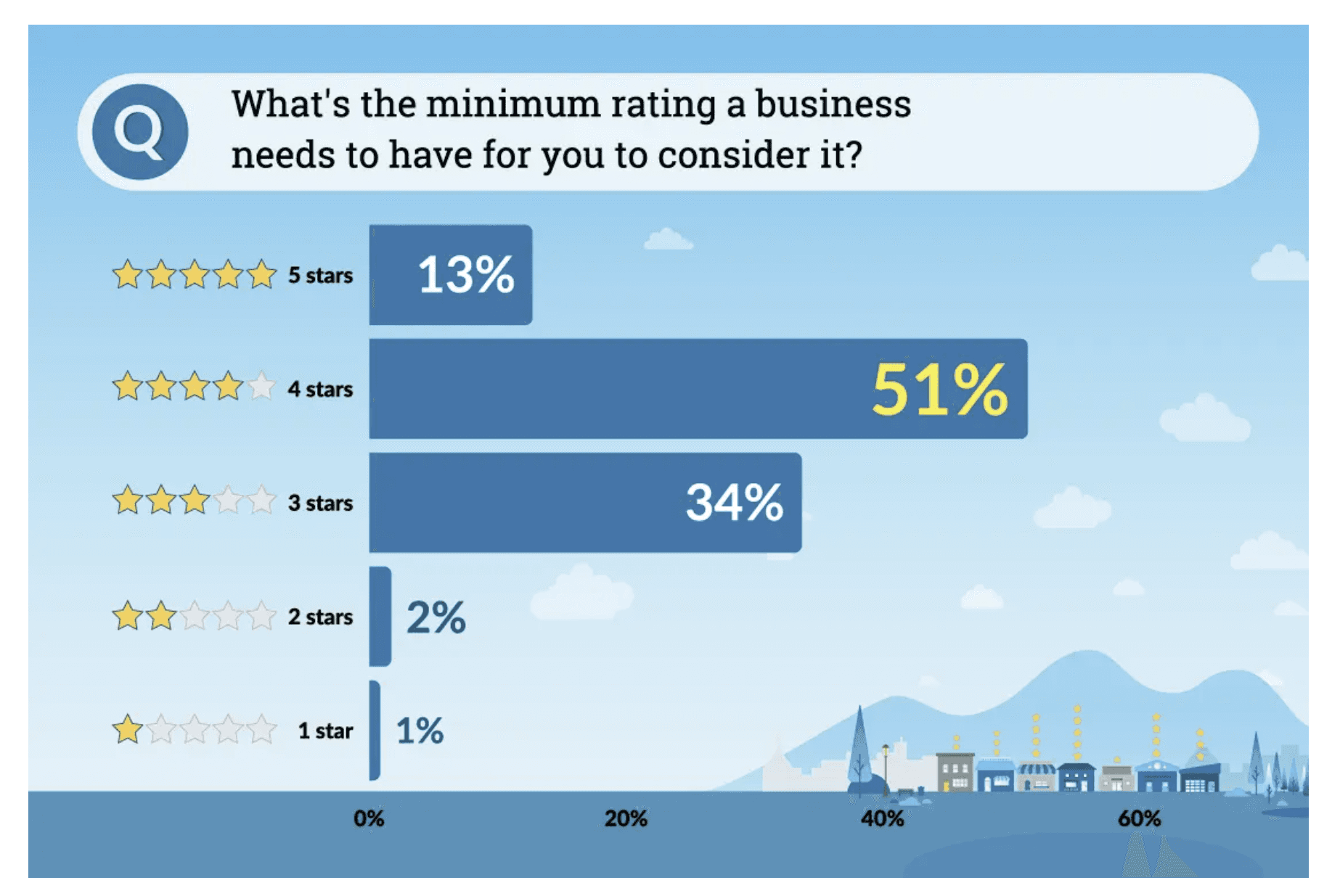
Chances are, if your reputation is below 4 stars, you’ll have some work ahead of you in both improving customer experiences and in actively seeking reviews so that a small number of negative reviews isn’t having an outsized impact on your average rating. For a complete tutorial, read How to Repair and Improve Local Business Reputation via Google Star Ratings and Reviews. Embrace the welcome news that 37% of customers may still give your business a chance, even with a less-than-four-star rating, and this may give you the time you need to make strategic business changes to raise your rating and start winning better rankings and more customers.
7. Additional Google Business Profile categories
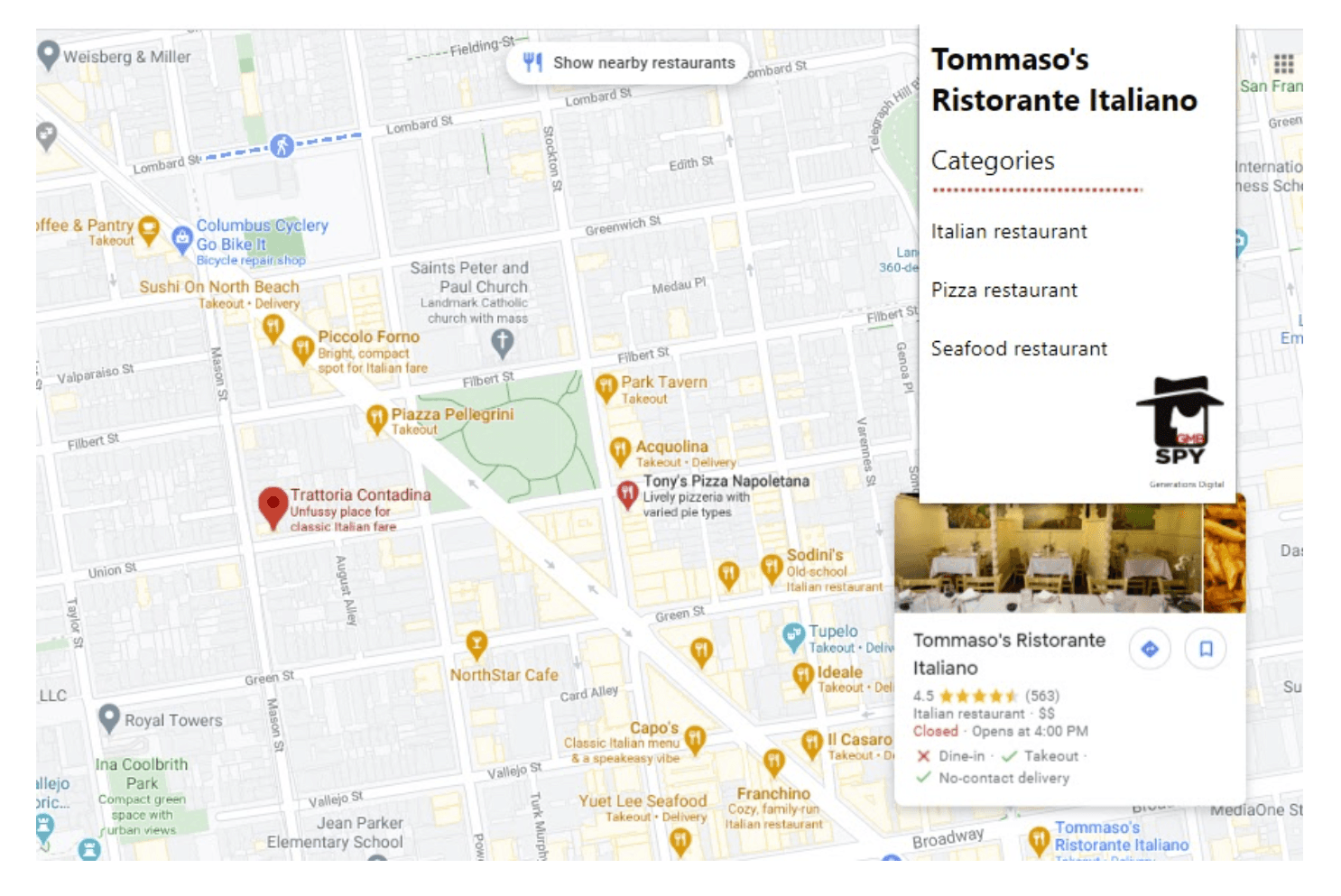
The fact that two of the top seven local search ranking factors relate to categories emphasizes just how important these small elements are. Once you’ve selected your most influential primary category, you have nine more chances to help Google understand your relevance to specific customer intents.
Inspiration for filling in those category fields is easiest to find if you either download the GMBSpy Chrome extension or fire up GMB Everywhere to see all of the categories your top local competitors have chosen. If they relate to your business, add them to your profile. Then, read How to Choose GBP Categories (With Cool Tools) for further suggestions on researching and implementing the right identifiers of your business. Over time, keep an eye on Sterling Sky’s running tally of new business categories, in case Google adds something that was previously missing and helps further describe what your business is.
And that’s it for today! Once you’ve gotten a great handle on perfecting your management of the top 7 local search ranking factors, move on to tackle the rest by reading WhiteSpark’s full report. Meanwhile, if you’ve got a new tip or tactic for climbing up the local pack rankings, please don’t hesitate to @ Moz on Twitter!
MARKETING
How to Use AI For a More Effective Social Media Strategy, According to Ross Simmonds

Welcome to Creator Columns, where we bring expert HubSpot Creator voices to the Blogs that inspire and help you grow better.
It’s the age of AI, and our job as marketers is to keep up.
My team at Foundation Marketing recently conducted an AI Marketing study surveying hundreds of marketers, and more than 84% of all leaders, managers, SEO experts, and specialists confirmed that they used AI in the workplace.

If you can overlook the fear-inducing headlines, this technology is making social media marketers more efficient and effective than ever. Translation: AI is good news for social media marketers.
In fact, I predict that the marketers not using AI in their workplace will be using it before the end of this year, and that number will move closer and closer to 100%.
Social media and AI are two of the most revolutionizing technologies of the last few decades. Social media has changed the way we live, and AI is changing the way we work.
So, I’m going to condense and share the data, research, tools, and strategies that the Foundation Marketing Team and I have been working on over the last year to help you better wield the collective power of AI and social media.
Let’s jump into it.
What’s the role of AI in social marketing strategy?
In a recent episode of my podcast, Create Like The Greats, we dove into some fascinating findings about the impact of AI on marketers and social media professionals. Take a listen here:
Let’s dive a bit deeper into the benefits of this technology:
Benefits of AI in Social Media Strategy
AI is to social media what a conductor is to an orchestra — it brings everything together with precision and purpose. The applications of AI in a social media strategy are vast, but the virtuosos are few who can wield its potential to its fullest.
AI to Conduct Customer Research
Imagine you’re a modern-day Indiana Jones, not dodging boulders or battling snakes, but rather navigating the vast, wild terrain of consumer preferences, trends, and feedback.
This is where AI thrives.
Using social media data, from posts on X to comments and shares, AI can take this information and turn it into insights surrounding your business and industry. Let’s say for example you’re a business that has 2,000 customer reviews on Google, Yelp, or a software review site like Capterra.
Leveraging AI you can now have all 2,000 of these customer reviews analyzed and summarized into an insightful report in a matter of minutes. You simply need to download all of them into a doc and then upload them to your favorite Generative Pre-trained Transformer (GPT) to get the insights and data you need.
But that’s not all.
You can become a Prompt Engineer and write ChatGPT asking it to help you better understand your audience. For example, if you’re trying to come up with a persona for people who enjoy marathons but also love kombucha you could write a prompt like this to ChatGPT:

The response that ChatGPT provided back is quite good:

Below this it went even deeper by including a lot of valuable customer research data:
- Demographics
- Psychographics
- Consumer behaviors
- Needs and preferences
And best of all…
It also included marketing recommendations.
The power of AI is unbelievable.
Social Media Content Using AI
AI’s helping hand can be unburdening for the creative spirit.
Instead of marketers having to come up with new copy every single month for posts, AI Social Caption generators are making it easier than ever to craft catchy status updates in the matter of seconds.
Tools like HubSpot make it as easy as clicking a button and telling the AI tool what you’re looking to create a post about:

The best part of these AI tools is that they’re not limited to one channel.
Your AI social media content assistant can help you with LinkedIn content, X content, Facebook content, and even the captions that support your post on Instagram.
It can also help you navigate hashtags:

With AI social media tools that generate content ideas or even write posts, it’s not about robots replacing humans. It’s about making sure that the human creators on your team are focused on what really matters — adding that irreplaceable human touch.
Enhanced Personalization
You know that feeling when a brand gets you, like, really gets you?
AI makes that possible through targeted content that’s tailored with a level of personalization you’d think was fortune-telling if the data didn’t paint a starker, more rational picture.
What do I mean?
Brands can engage more quickly with AI than ever before. In the early 2000s, a lot of brands spent millions of dollars to create social media listening rooms where they would hire social media managers to find and engage with any conversation happening online.
Thanks to AI, brands now have the ability to do this at scale with much fewer people all while still delivering quality engagement with the recipient.
Analytics and Insights
Tapping into AI to dissect the data gives you a CSI-like precision to figure out what works, what doesn’t, and what makes your audience tick. It’s the difference between guessing and knowing.
The best part about AI is that it can give you almost any expert at your fingertips.
If you run a report surrounding the results of your social media content strategy directly from a site like LinkedIn, AI can review the top posts you’ve shared and give you clear feedback on what type of content is performing, why you should create more of it, and what days of the week your content is performing best.
This type of insight that would typically take hours to understand.
Now …
Thanks to the power of AI you can upload a spreadsheet filled with rows and columns of data just to be met with a handful of valuable insights a few minutes later.
Improved Customer Service
Want 24/7 support for your customers?
It’s now possible without human touch.
Chatbots powered by AI are taking the lead on direct messaging experiences for brands on Facebook and other Meta properties to offer round-the-clock assistance.
The fact that AI can be trained on past customer queries and data to inform future queries and problems is a powerful development for social media managers.
Advertising on Social Media with AI
The majority of ad networks have used some variation of AI to manage their bidding system for years. Now, thanks to AI and its ability to be incorporated in more tools, brands are now able to use AI to create better and more interesting ad campaigns than ever before.
Brands can use AI to create images using tools like Midjourney and DALL-E in seconds.
Brands can use AI to create better copy for their social media ads.
Brands can use AI tools to support their bidding strategies.
The power of AI and social media is continuing to evolve daily and it’s not exclusively found in the organic side of the coin. Paid media on social media is being shaken up due to AI just the same.
How to Implement AI into Your Social Media Strategy
Ready to hit “Go” on your AI-powered social media revolution?
Don’t just start the engine and hope for the best. Remember the importance of building a strategy first. In this video, you can learn some of the most important factors ranging from (but not limited to) SMART goals and leveraging influencers in your day-to-day work:
The following seven steps are crucial to building a social media strategy:
- Identify Your AI and Social Media Goals
- Validate Your AI-Related Assumptions
- Conduct Persona and Audience Research
- Select the Right Social Channels
- Identify Key Metrics and KPIs
- Choose the Right AI Tools
- Evaluate and Refine Your Social Media and AI Strategy
Keep reading, roll up your sleeves, and follow this roadmap:
1. Identify Your AI and Social Media Goals
If you’re just dipping your toes into the AI sea, start by defining clear objectives.
Is it to boost engagement? Streamline your content creation? Or simply understand your audience better? It’s important that you spend time understanding what you want to achieve.
For example, say you’re a content marketing agency like Foundation and you’re trying to increase your presence on LinkedIn. The specificity of this goal will help you understand the initiatives you want to achieve and determine which AI tools could help you make that happen.
Are there AI tools that will help you create content more efficiently? Are there AI tools that will help you optimize LinkedIn Ads? Are there AI tools that can help with content repurposing? All of these things are possible and having a goal clearly identified will help maximize the impact. Learn more in this Foundation Marketing piece on incorporating AI into your content workflow.
Once you have identified your goals, it’s time to get your team on board and assess what tools are available in the market.
Recommended Resources:
2. Validate Your AI-Related Assumptions
Assumptions are dangerous — especially when it comes to implementing new tech.
Don’t assume AI is going to fix all your problems.
Instead, start with small experiments and track their progress carefully.
3. Conduct Persona and Audience Research
Social media isn’t something that you can just jump into.
You need to understand your audience and ideal customers. AI can help with this, but you’ll need to be familiar with best practices. If you need a primer, this will help:
Once you understand the basics, consider ways in which AI can augment your approach.
4. Select the Right Social Channels
Not every social media channel is the same.
It’s important that you understand what channel is right for you and embrace it.
The way you use AI for X is going to be different from the way you use AI for LinkedIn. On X, you might use AI to help you develop a long-form thread that is filled with facts and figures. On LinkedIn however, you might use AI to repurpose a blog post and turn it into a carousel PDF. The content that works on X and that AI can facilitate creating is different from the content that you can create and use on LinkedIn.
The audiences are different.
The content formats are different.
So operate and create a plan accordingly.
Recommended Tools and Resources:
5. Identify Key Metrics and KPIs
What metrics are you trying to influence the most?
Spend time understanding the social media metrics that matter to your business and make sure that they’re prioritized as you think about the ways in which you use AI.
These are a few that matter most:
- Reach: Post reach signifies the count of unique users who viewed your post. How much of your content truly makes its way to users’ feeds?
- Clicks: This refers to the number of clicks on your content or account. Monitoring clicks per campaign is crucial for grasping what sparks curiosity or motivates people to make a purchase.
- Engagement: The total social interactions divided by the number of impressions. This metric reveals how effectively your audience perceives you and their readiness to engage.
Of course, it’s going to depend greatly on your business.
But with this information, you can ensure that your AI social media strategy is rooted in goals.
6. Choose the Right AI Tools
The AI landscape is filled with trash and treasure.
Pick AI tools that are most likely to align with your needs and your level of tech-savviness.
For example, if you’re a blogger creating content about pizza recipes, you can use HubSpot’s AI social caption generator to write the message on your behalf:

The benefit of an AI tool like HubSpot and the caption generator is that what at one point took 30-40 minutes to come up with — you can now have it at your fingertips in seconds. The HubSpot AI caption generator is trained on tons of data around social media content and makes it easy for you to get inspiration or final drafts on what can be used to create great content.
Consider your budget, the learning curve, and what kind of support the tool offers.
7. Evaluate and Refine Your Social Media and AI Strategy
AI isn’t a magic wand; it’s a set of complex tools and technology.
You need to be willing to pivot as things come to fruition.
If you notice that a certain activity is falling flat, consider how AI can support that process.
Did you notice that your engagement isn’t where you want it to be? Consider using an AI tool to assist with crafting more engaging social media posts.
Make AI Work for You — Now and in the Future
AI has the power to revolutionize your social media strategy in ways you may have never thought possible. With its ability to conduct customer research, create personalized content, and so much more, thinking about the future of social media is fascinating.
We’re going through one of the most interesting times in history.
Stay equipped to ride the way of AI and ensure that you’re embracing the best practices outlined in this piece to get the most out of the technology.
MARKETING
Advertising in local markets: A playbook for success

Many brands, such as those in the home services industry or a local grocery chain, market to specific locations, cities or regions. There are also national brands that want to expand in specific local markets.
Regardless of the company or purpose, advertising on a local scale has different tactics than on a national scale. Brands need to connect their messaging directly with the specific communities they serve and media to their target demo. Here’s a playbook to help your company succeed when marketing on a local scale.
1. Understand local vs. national campaigns
Local advertising differs from national campaigns in several ways:
- Audience specificity: By zooming in on precise geographic areas, brands can tailor messaging to align with local communities’ customs, preferences and nuances. This precision targeting ensures that your message resonates with the right target audience.
- Budget friendliness: Local advertising is often more accessible for small businesses. Local campaign costs are lower, enabling brands to invest strategically within targeted locales. This budget-friendly nature does not diminish the need for strategic planning; instead, it emphasizes allocating resources wisely to maximize returns. As a result, testing budgets can be allocated across multiple markets to maximize learnings for further market expansion.
- Channel selection: Selecting the correct channels is vital for effective local advertising. Local newspapers, radio stations, digital platforms and community events each offer advantages. The key lies in understanding where your target audience spends time and focusing efforts to ensure optimal engagement.
- Flexibility and agility: Local campaigns can be adjusted more swiftly in response to market feedback or changes, allowing brands to stay relevant and responsive.
Maintaining brand consistency across local touchpoints reinforces brand identity and builds a strong, recognizable brand across markets.
2. Leverage customized audience segmentation
Customized audience segmentation is the process of dividing a market into distinct groups based on specific demographic criteria. This marketing segmentation supports the development of targeted messaging and media plans for local markets.
For example, a coffee chain might cater to two distinct segments: young professionals and retirees. After identifying these segments, the chain can craft messages, offers and media strategies relating to each group’s preferences and lifestyle.
To reach young professionals in downtown areas, the chain might focus on convenience, quality coffee and a vibrant atmosphere that is conducive to work and socializing. Targeted advertising on Facebook, Instagram or Connected TV, along with digital signage near office complexes, could capture the attention of this demographic, emphasizing quick service and premium blends.
Conversely, for retirees in residential areas, the chain could highlight a cozy ambiance, friendly service and promotions such as senior discounts. Advertisements in local print publications, community newsletters, radio stations and events like senior coffee mornings would foster a sense of community and belonging.
Dig deeper: Niche advertising: 7 actionable tactics for targeted marketing
3. Adapt to local market dynamics
Various factors influence local market dynamics. Brands that navigate changes effectively maintain a strong audience connection and stay ahead in the market. Here’s how consumer sentiment and behavior may evolve within a local market and the corresponding adjustments brands can make.
- Cultural shifts, such as changes in demographics or societal norms, can alter consumer preferences within a local community. For example, a neighborhood experiencing gentrification may see demand rise for specific products or services.
- Respond by updating your messaging to reflect the evolving cultural landscape, ensuring it resonates with the new demographic profile.
- Economic conditions are crucial. For example, during downturns, consumers often prioritize value and practicality.
- Highlight affordable options or emphasize the practical benefits of your offerings to ensure messaging aligns with consumers’ financial priorities. The impact is unique to each market and the marketing message must also be dynamic.
- Seasonal trends impact consumer behavior.
- Align your promotions and creative content with changing seasons or local events to make your offerings timely and relevant.
- New competitors. The competitive landscape demands vigilance because new entrants or innovative competitor campaigns can shift consumer preferences.
- Differentiate by focusing on your unique selling propositions, such as quality, customer service or community involvement, to retain consumer interest and loyalty.
4. Apply data and predictive analytics
Data and predictive analytics are indispensable tools for successfully reaching local target markets. These technologies provide consumer behavior insights, enabling you to anticipate market trends and adjust strategies proactively.
- Price optimization: By analyzing consumer demand, competitor pricing and market conditions, data analytics enables you to set prices that attract customers while ensuring profitability.
- Competitor analysis: Through analysis, brands can understand their positioning within the local market landscape and identify opportunities and threats. Predictive analytics offer foresight into competitors’ potential moves, allowing you to strategize effectively to maintain a competitive edge.
- Consumer behavior: Forecasting consumer behavior allows your brand to tailor offerings and marketing messages to meet evolving consumer needs and enhance engagement.
- Marketing effectiveness: Analytics track the success of advertising campaigns, providing insights into which strategies drive conversions and sales. This feedback loop enables continuous optimization of marketing efforts for maximum impact.
- Inventory management: In supply chain management, data analytics predict demand fluctuations, ensuring inventory levels align with market needs. This efficiency prevents stockouts or excess inventory, optimizing operational costs and meeting consumer expectations.
Dig deeper: Why you should add predictive modeling to your marketing mix
5. Counter external market influences
Consider a clothing retailer preparing for a spring collection launch. By analyzing historical weather data and using predictive analytics, the brand forecasts an unseasonably cool start to spring. Anticipating this, the retailer adjusts its campaign to highlight transitional pieces suitable for cooler weather, ensuring relevance despite an unexpected chill.
Simultaneously, predictive models signal an upcoming spike in local media advertising rates due to increased market demand. Retailers respond by reallocating a portion of advertising budgets to digital channels, which offer more flexibility and lower costs than traditional media. This shift enables brands to maintain visibility and engagement without exceeding budget, mitigating the impact of external forces on advertising.
6. Build consumer confidence with messaging
Localized messaging and tailored customer service enhance consumer confidence by demonstrating your brand’s understanding of the community. For instance, a grocery store that curates cooking classes featuring local cuisine or sponsors community events shows commitment to local culture and consumer interests.
Similarly, a bookstore highlighting local authors or topics relevant to the community resonates with local customers. Additionally, providing service that addresses local needs — such as bilingual service and local event support — reinforces the brand’s values and response to the community.
Through these localized approaches, brands can build trust and loyalty, bridging the gap between corporate presence and local relevance.
7. Dominate with local advertising
To dominate local markets, brands must:
- Harness hyper-targeted segmentation and geo-targeted advertising to reach and engage precise audiences.
- Create localized content that reflects community values, engage in community events, optimize campaigns for mobile and track results.
- Fine-tune strategies, outperform competitors and foster lasting relationships with customers.
These strategies will enable your message to resonate with local consumers, differentiate you in competitive markets and ensure you become a major player in your specific area.
Dig deeper: The 5 critical elements for local marketing success
Opinions expressed in this article are those of the guest author and not necessarily MarTech. Staff authors are listed here.
MARKETING
Battling for Attention in the 2024 Election Year Media Frenzy


As we march closer to the 2024 U.S. presidential election, CMOs and marketing leaders need to prepare for a significant shift in the digital advertising landscape. Election years have always posed unique challenges for advertisers, but the growing dominance of digital media has made the impact more profound than ever before.
In this article, we’ll explore the key factors that will shape the advertising environment in the coming months and provide actionable insights to help you navigate these turbulent waters.
The Digital Battleground
The rise of cord-cutting and the shift towards digital media consumption have fundamentally altered the advertising landscape in recent years. As traditional TV viewership declines, political campaigns have had to adapt their strategies to reach voters where they are spending their time: on digital platforms.


According to a recent report by eMarketer, the number of cord-cutters in the U.S. is expected to reach 65.1 million by the end of 2023, representing a 6.9% increase from 2022. This trend is projected to continue, with the number of cord-cutters reaching 72.2 million by 2025.
Moreover, a survey conducted by Pew Research Center in 2023 found that 62% of U.S. adults do not have a cable or satellite TV subscription, up from 61% in 2022 and 50% in 2019. This data further underscores the accelerating shift away from traditional TV and towards streaming and digital media platforms.
As these trends continue, political advertisers will have no choice but to follow their audiences to digital channels. In the 2022 midterm elections, digital ad spending by political campaigns reached $1.2 billion, a 50% increase from the 2018 midterms. With the 2024 presidential election on the horizon, this figure is expected to grow exponentially, as campaigns compete for the attention of an increasingly digital-first electorate.
For brands and advertisers, this means that the competition for digital ad space will be fiercer than ever before. As political ad spending continues to migrate to platforms like Meta, YouTube, and connected TV, the cost of advertising will likely surge, making it more challenging for non-political advertisers to reach their target audiences.
To navigate this complex and constantly evolving landscape, CMOs and their teams will need to be proactive, data-driven, and willing to experiment with new strategies and channels. By staying ahead of the curve and adapting to the changing media consumption habits of their audiences, brands can position themselves for success in the face of the electoral advertising onslaught.
Rising Costs and Limited Inventory
As political advertisers flood the digital market, the cost of advertising is expected to skyrocket. CPMs (cost per thousand impressions) will likely experience a steady climb throughout the year, with significant spikes anticipated in May, as college students come home from school and become more engaged in political conversations, and around major campaign events like presidential debates.


For media buyers and their teams, this means that the tried-and-true strategies of years past may no longer be sufficient. Brands will need to be nimble, adaptable, and willing to explore new tactics to stay ahead of the game.
Black Friday and Cyber Monday: A Perfect Storm
The challenges of election year advertising will be particularly acute during the critical holiday shopping season. Black Friday and Cyber Monday, which have historically been goldmines for advertisers, will be more expensive and competitive than ever in 2024, as they coincide with the final weeks of the presidential campaign.
To avoid being drowned out by the political noise, brands will need to start planning their holiday campaigns earlier than usual. Building up audiences and crafting compelling creative assets well in advance will be essential to success, as will a willingness to explore alternative channels and tactics. Relying on cold audiences come Q4 will lead to exceptionally high costs that may be detrimental to many businesses.
Navigating the Chaos
While the challenges of election year advertising can seem daunting, there are steps that media buyers and their teams can take to mitigate the impact and even thrive in this environment. Here are a few key strategies to keep in mind:
Start early and plan for contingencies: Begin planning your Q3 and Q4 campaigns as early as possible, with a focus on building up your target audiences and developing a robust library of creative assets.
Be sure to build in contingency budgets to account for potential cost increases, and be prepared to pivot your strategy as the landscape evolves.


Embrace alternative channels: Consider diversifying your media mix to include channels that may be less impacted by political ad spending, such as influencer marketing, podcast advertising, or sponsored content. Investing in owned media channels, like email marketing and mobile apps, can also provide a direct line to your customers without the need to compete for ad space.
Owned channels will be more important than ever. Use cheaper months leading up to the election to build your email lists and existing customer base so that your BF/CM can leverage your owned channels and warm audiences.
Craft compelling, shareable content: In a crowded and noisy advertising environment, creating content that resonates with your target audience will be more important than ever. Focus on developing authentic, engaging content that aligns with your brand values and speaks directly to your customers’ needs and desires.
By tapping into the power of emotional triggers and social proof, you can create content that not only cuts through the clutter but also inspires organic sharing and amplification.
Reflections
The 2024 election year will undoubtedly bring new challenges and complexities to the world of digital advertising. But by staying informed, adaptable, and strategic in your approach, you can navigate this landscape successfully and even find new opportunities for growth and engagement.
As a media buyer or agnecy, your role in steering your brand through these uncharted waters will be critical. By starting your planning early, embracing alternative channels and tactics, and focusing on creating authentic, resonant content, you can not only survive but thrive in the face of election year disruptions.
So while the road ahead may be uncertain, one thing is clear: the brands that approach this challenge with creativity, agility, and a steadfast commitment to their customers will be the ones that emerge stronger on the other side.
-

 PPC4 days ago
PPC4 days ago19 Best SEO Tools in 2024 (For Every Use Case)
-

 PPC7 days ago
PPC7 days ago4 New Google Ads Performance Max Updates: What You Need to Know
-

 MARKETING7 days ago
MARKETING7 days agoWill Google Buy HubSpot? | Content Marketing Institute
-
SEARCHENGINES6 days ago
Daily Search Forum Recap: April 16, 2024
-

 SEO6 days ago
SEO6 days agoGoogle Clarifies Vacation Rental Structured Data
-

 MARKETING6 days ago
MARKETING6 days agoStreamlining Processes for Increased Efficiency and Results
-
SEARCHENGINES5 days ago
Daily Search Forum Recap: April 17, 2024
-

 PPC7 days ago
PPC7 days agoHow to Collect & Use Customer Data the Right (& Ethical) Way














![How to Use AI For a More Effective Social Media Strategy, According to Ross Simmonds Download Now: The 2024 State of Social Media Trends [Free Report]](https://articles.entireweb.com/wp-content/uploads/2024/04/How-to-Use-AI-For-a-More-Effective-Social-Media.png)



